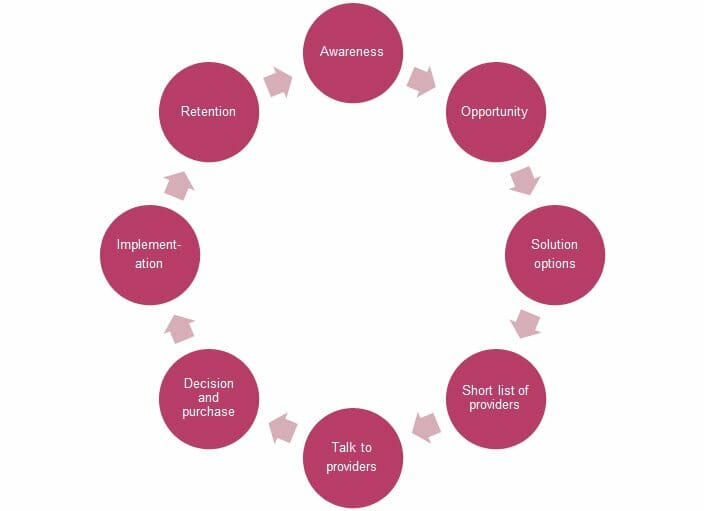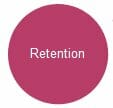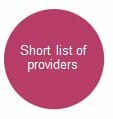In a previous post, I spoke about the B2B customer journey. Here I concentrate on how to address each step of this customer journey using marketing communications tools and strategies.

Marketing communications is about understanding your target market’s problems and to effectively convey how your product solves those problems using various channels. You need to educate your target market on how you solve the problem and the value you bring to meeting your prospects’ needs.
Defining the stage your buyer is at on their B2B customer journey enables you to provide the right communications tools to move them along to the next stage.
1. Awareness
 To help your prospects realise that you have a solution to a problem they don’t know about, the best way to do this is through PR (public relations). Inspiring case studies and thought leadership articles dotted around the publications that your target market reads will help them realise the value you can bring to their business.
To help your prospects realise that you have a solution to a problem they don’t know about, the best way to do this is through PR (public relations). Inspiring case studies and thought leadership articles dotted around the publications that your target market reads will help them realise the value you can bring to their business.
2. Opportunity
This is when the customer starts the web search. SEO and specific landing pages to identify how you solve their problem and bring benefits to the customer are the best tools at this stage of the B2B customer journey. PR as mentioned in 1 above also helps at this stage.
3. Software options
 Ensure your customer can get all they information the need on your website, including brochures and case studies, at the click of a button. CTAs should be clear and easy to follow. At this stage, sign up forms to download case studies or white papers will deter them from progressing with your company further. (Or any stage in fact, I’m against most gated content).
Ensure your customer can get all they information the need on your website, including brochures and case studies, at the click of a button. CTAs should be clear and easy to follow. At this stage, sign up forms to download case studies or white papers will deter them from progressing with your company further. (Or any stage in fact, I’m against most gated content).
Case studies and customer testimonials should be easily found on your website. At stage 5 and/or 6, it is likely that they will request a customer reference visit. So be sure to have friendly customers who are willing to help.
4. Short list
To be included in the short list you must ensure that your Customer Value Proposition and Unique Selling Proposition are strong and obvious to your prospects. The CVP differentiates you and is your best ally at this stage (and in all stages).

This image was created using Craiyon, an AI tool that creates images from text. The description I used was “B2B customer journey marketing with purple background.”
5. Conversation with shortlisted software providers
 Ensure that when your prospect wishes to contact you, it can be done easily. Offer a variety of methods including email and phone via your website. Including a”book a call” CTA via Calendly or CalendarHero will enable your customers to independently book a time that suits. Your first conversation with your customer needs to be a chat, defining how you can help, rather than a software demo. The demo can be arranged during this chat. It is likely that towards the end of this stage, reference visits may be required.
Ensure that when your prospect wishes to contact you, it can be done easily. Offer a variety of methods including email and phone via your website. Including a”book a call” CTA via Calendly or CalendarHero will enable your customers to independently book a time that suits. Your first conversation with your customer needs to be a chat, defining how you can help, rather than a software demo. The demo can be arranged during this chat. It is likely that towards the end of this stage, reference visits may be required.
6. Decision and purchase
Make the purchase process easy – don’t let your customer get caught up in your internal processes in order to buy from you.
7. Implementation
 Ensure your customer approves your implementation plan and knows exactly how much effort they need to put into this phase.
Ensure your customer approves your implementation plan and knows exactly how much effort they need to put into this phase.
8. Retention
 Ongoing marketing communications through newsletters and emails is vital to keep your customers up to date with trends and new features. Regular account manager contact is also crucial.
Ongoing marketing communications through newsletters and emails is vital to keep your customers up to date with trends and new features. Regular account manager contact is also crucial.
The marketing tactics mentioned in these steps aren’t restricted to just these steps. But most of your customer’s research will be done long before you speak to them.
I hope this helps you with knowing how to address the stages of the B2B customer journey through marketing. Have you any other ideas? Post in the comment section below.




